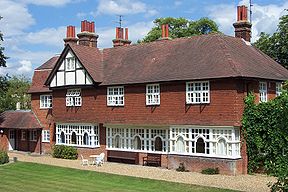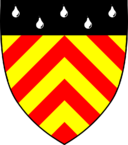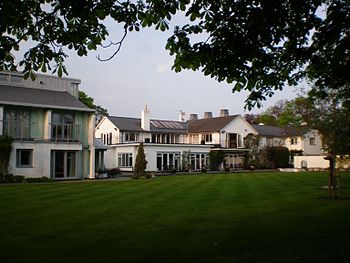- Clare Hall, Cambridge
-
Colleges of the University of Cambridge
Clare Hall

Named after Clare College Established 1966 Admittance Men and women President Sir Martin Harris Undergraduates None Graduates 145 Sister college St Cross College, Oxford Location Herschel Road (map) 
College website Boat Club website Clare Hall is a constituent college of the University of Cambridge, England. It is a college for advanced study, admitting only postgraduate students.
Informality is a defining value at Clare Hall and this contributes to its unique character. Unlike other colleges in the university, Clare Hall does not have a high table at meals or a senior common room, and it is a single society for all social functions and in the use of the various college common rooms and other facilities. This encourages interaction between graduate students, distinguished visiting fellows and other senior members, aided also by the wide variety of national backgrounds and research interests of the members.
The interaction between members of Clare Hall is encouraged also by college seminars, lunchtime discussions and formal lecture series. The latter includes the annual series of lectures relating to human values, given by a distinguished international scholar and sponsored by the Tanner Foundation. They also include the annual Ashby lecture, given by a visiting fellow, and the more frequent ASH seminar (arts, social sciences and history) that were initiated by some of the visiting life members. Other events include art exhibitions, films and small concerts which supplement the wealth of music available in the university. The college retains strong links with scholars, universities and political and industry leaders in Asia, the Pacific, Africa, Europe and America. This provides a culturally rich and professionally diverse environment for academic research. Distinguished academics from universities all over the world intending to visit Cambridge during a period of study leave may apply to the college, and the Fellowship Committee recommends successful candidates for election for up to one year.
Other facilities in the college grounds include a sports complex with a multi-gym and swimming pool and an adjacent tennis court. It also boasts the finest dining room, food & wine and Formal Hall as rated by Varsity, a Cambridge University student run magazine. The university athletics track is a short run from the main college buildings.
It is one of the smallest colleges with 145 graduate students but around 125 Fellows, making it the highest Fellow to Student ratio at Cambridge University.
Contents
Foundation and history
Clare Hall was founded by Clare College (which had previously been known as "Clare Hall" from 1338–1856) as a centre for advanced study, but was also intended to become a social group of men and women with their families that would include graduate students studying for higher degrees in the university, research fellows working at post-doctoral level, permanent fellows holding faculty or research posts in the university, and visiting fellows on leave from universities around the world.
After Clare College decided to establish this new centre in January 1964, the initial planning was carried through by a small group of fellows of the college chaired by the Master, Sir Eric Ashby (later to become Lord Ashby of Brandon). It was soon agreed that the new centre would be called Clare Hall, the ancient name by which the college itself had been known for more than five hundred years until the mid-19th century.
The Institute of Advanced Studies at the University of Bologna is so far the only institution abroad explicitly modelled upon Clare Hall.
New buildings
The architect Ralph Erskine was appointed to design the buildings for Clare Hall, which were to include common rooms, offices and dining facilities, a house for the President, and twenty apartments for visiting fellows. A neighbouring house, Elmside in Grange Road, provided rooms for the relatively small number of graduate students.
Sir Eric Ashby, then Master of Clare College and Vice-Chancellor of the University, formally opened Clare Hall in September 1969. Brian Pippard, the first President of Clare Hall, had already moved into the President’s house with his family, twelve research students were living on the college site in Elmside and a number of visiting fellows with their families were living in the newly built college apartments. Among the early visiting fellows was Ivar Giaever, who was awarded a Nobel Prize for Physics in 1973. Joseph Brodsky, a visiting fellow and poet in residence at Clare Hall in 1977, was awarded the Nobel Prize for Literature in 1987.
Growth and development
In 1978 a second neighbouring house, now called Leslie Barnett House, was obtained for graduate student accommodation. This purchase also allowed the Michael Stoker and Brian Pippard Buildings to be built in the college grounds, providing further student rooms. The Anthony Low Building in the garden of Elmside was completed in 2000, providing further common rooms and the Garden Bar for the graduates on the main college site.
In the summer of 1996, the college purchased a substantial property, formerly the Cambridge family home of Victor Rothschild, 3rd Baron Rothschild, which is about five minutes' walk from the college at the end of Herschel Road. It was renamed Clare Hall West Court and, after conversion and some major building works, now provides public rooms, studies, apartments, study bedrooms, a fitness centre, a swimming pool, and a tennis court.
Presidents
The President’s term of office is fixed at seven years. In 1973, Robert Honeycombe (later Sir Robert), Goldsmiths Professor and Head of the Department of Metallurgy, succeeded Brian Pippard as President of Clare Hall. Subsequent Presidents were Sir Michael Stoker (1980-87), Foreign Secretary of the Royal Society and a former fellow and medical tutor at Clare College, who had taken early retirement from his post as Director of the Imperial Cancer Research Laboratories; Anthony Low (1987–94), Professor of Commonwealth History and formerly Vice-Chancellor of the Australian National University, who had been a visiting fellow of Clare Hall in 1971; and Professor Dame Gillian Beer (1994–2001), King Edward VII Professor of English Literature.
Professor Ekhard Salje FRS, Head of the Department of Earth Sciences, was President of Clare Hall from 2001 until 2008 after holding professorships in Germany and France. He was succeeded by Sir Martin Harris, former Vice-Chancellor of the University of Manchester.
Fellows
The late Lord Ashby was elected as the first honorary fellow of Clare Hall in 1975, on his retirement from the Mastership of Clare College.
Present honorary fellows include two former visiting fellows, Kim Dae-Jung, former President of the Republic of Korea, and Lee Bollinger, who later became President of the Universities of Michigan and Columbia. They also include the retired Presidents of the College, together with Ralph Erskine, architect of the early buildings, and Richard Eden, one of the founding fellows.
Clare Hall has a strong tradition in theoretical physics. Brian Pippard was the first president of Clare Hall. Notable current fellows include Michael Green, the Lucasian Professor of Mathematics, and John D. Barrow. Past fellows include Stephen Adler of the Institute for Advanced Study, Michael R. Douglas of Stony Brook University, J. David Jackson of the University of California, Berkeley, William Paul of Harvard University.
Other American academics who were past fellows include Andreas Acrivos (fluid dynamics) of Stanford, Leila Ahmed (divinity) of Harvard, David Epel (marine biology) of Stanford, Elizabeth Gavis (molecular biology) of Princeton, Robert Glaeser (biochemistry and molecular biology) of Berkeley, Jeanne C. Marsh (social service administration) of Chicago Christine Shoemaker (civil and environmental engineering) of Cornell, Robert Socolow (mechanical and aerospace engineering) of Princeton.
Roy Martin Haines, sometime Professor of Medieval History in Dalhousie University, was a Visiting Fellow in 1987/8 and in 1990 was appointed a life member of the college.
See also
- Category:Fellows of Clare Hall, Cambridge
- Category:Honorary Fellows of Clare Hall, Cambridge
- Category:Alumni of Clare Hall, Cambridge
- Clare Hall Boat Club
References
- Clare Hall (2007). "Clare Hall — The College". http://www.clarehall.cam.ac.uk/index.php?id=101. Retrieved 24 January 2007.
- Richard Eden (2009), Clare Hall. The Origins and Development of a College for Advanced Study, Cambridge.
External links
University of Cambridge 
Chancellor: The Lord Sainsbury of Turville (list) · Vice-Chancellor: Sir Leszek Borysiewicz (list)
Colleges: Christ’s • Churchill • Clare • Clare Hall • Corpus Christi • Darwin • Downing • Emmanuel • Fitzwilliam • Girton • Gonville and Caius • Homerton • Hughes Hall • Jesus • King’s • Lucy Cavendish • Magdalene • Murray Edwards (New Hall) • Newnham • Pembroke • Peterhouse • Queens’ • Robinson • St Catharine’s • St Edmund’s • St John’s • Selwyn • Sidney Sussex • Trinity • Trinity Hall • Wolfson
Categories: University • Chancellors • Vice-Chancellors • Colleges • Heads of Colleges • Departments • Academics • Alumni • Awards and Prizes
Websites: University • Students’ Union • Graduate Union

Coordinates: 52°12′19″N 0°06′14″E / 52.205139°N 0.103926°E
Categories:- Clare Hall, Cambridge
- Colleges of the University of Cambridge
- Postgraduate schools in the United Kingdom
- Educational institutions established in 1966
- 1966 establishments in England
Wikimedia Foundation. 2010.

